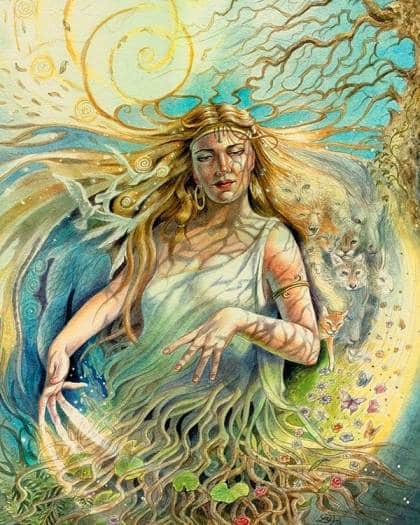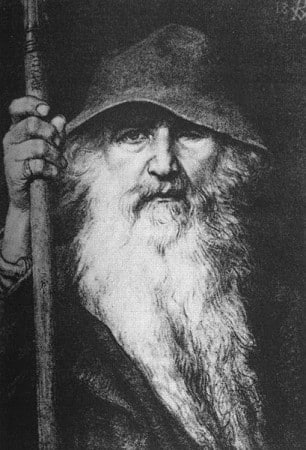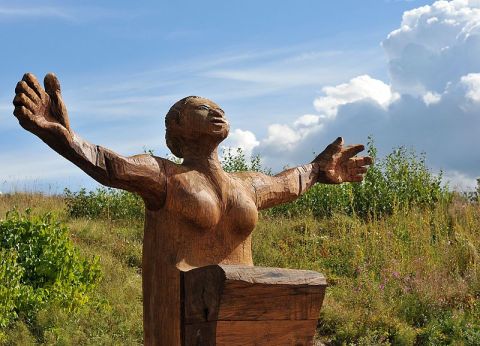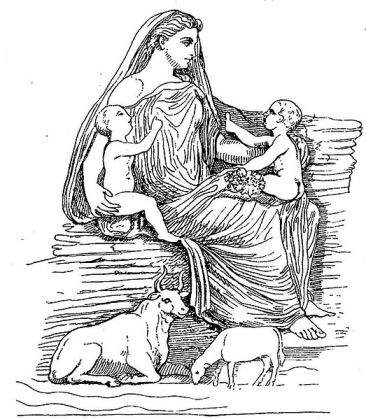When it comes to Norse mythology, we often hear about the mighty Thor, the wise Odin, or the cunning Loki. But have you ever wondered about the enigmatic goddess who gave birth to Thor? She’s called Jörd (Old Norse Jörð), and she’s the captivating Earth Goddess, and Jötun who personifies Midgard, the earth.
In this post I’ll explore the depths of her story, delving into her origins, her roles, and her influence, both in the ancient world and today. Certainly important in her own right, she is also influential in our understanding of both Thor and Odin.
Name and Etymology
To understand Jörd, we first need to examine her Old Norse name Jörð and the noun “jörð,” which translates to “earth” or “ground” in modern English. The term originates from the Proto-Germanic language, where it was known as “ertho” or “erþō.” This word evolved over time, giving rise to the Old English word “eorþe,” the Old High German “erda,” and, of course, the Old Norse “jörð.”
An interesting note might be that little has changed from the Old Norse a thousand years ago. The modern Norwegian word for dirt (like on the ground) is “jord”, and the earth is “jorden”. In the same fashion, the Old Norse for “the earth” with the definite article, is Jörðin.
Scholars consider Fjörgyn another name for Jörð, as both are described as Thor’s mother and used as poetic synonyms for ‘land’ or ‘earth’ in skaldic poems. Hlóðyn, mentioned in Völuspá for Thor (“son of Hlódyn”), is likely another synonym for Jörð.
Jörd’s role and significance in Norse mythology have also evolved over time. As the personification of the Earth, she has always been an essential figure. However, her relationships with other gods and her role in various myths have changed and grown more complex over time.
Family and Origins
To better understand Jörð’s place in Norse mythology, it’s essential to explore her family and origins. While her role as the personification of the Earth is well-established, her immediate family ties and lineage are more complex and require further examination.

In Gylfaginning, Jörð is described as the daughter of Nótt (Night) and Anarr (possibly another name for Odin). Nótt represents the night, and her various marriages have produced other offspring, including Dagr (Day), who is born from her union with Dellingr, the god of the dawn.
As a daughter of Nótt, Jörð inherits some of her mother’s primordial and elemental qualities. Her possible connection to Odin as her father Anarr also places her firmly within the divine Aesir family. However, it also adds some definitely ancient Greek aspects to this story where incestuous relationships are more common.
Is Odin Jörd’s Father?

The issue of Anarr maybe being Odin is based on a couple of mentions found in Gylfaginning ch. five discussing Jörd. They go like this:
“And for this reason, Odin is called Alfather, that he is the father of all gods and men, and of all things that were made by him and by his might. Jord (earth) was his daughter and his wife; with her he begat his first son, and that is Aesir-Thor. To him was given force and strength, whereby he conquers all things quickly.
Norfe, or Narfe, hight a giant, who dwelt in Jotunheim. He had a daughter by name Night. She was swarthy and dark like the race she belonged to. She was first married to a man named Naglfare. Their son was Aud.
Afterward she was married to Annar. Jord hight their daughter. Her last husband was Delling (Daybreak), who was of Aesir-race. Their son was Day, who was light and fair after his father.”
Based on this alone it is clear that Jörd is Odin’s daughter. She seems to come from the union of him and the primordial jötun giantess Nott (Night). However, I am not convinced this really reflects what was indeed their belief. The Aesir frown upon marriage to siblings or between parents and their children. This is clear in the story of the Vanir god Njord. When he is to move to Asgard, he isn’t allowed to bring his wife, because she is also his sister.
As it is said in the last paragraph, the father of Jörd is named Annar, not Odin. While it could be one of Odin’s many names, it could also prove that the earlier statement is a mix-up. It would not be Snorri’s first.
Siblings
Jörð’s siblings, as mentioned earlier, include Dagr, the personification of Day. Born from Nótt’s marriage to Dellingr, Dagr represents the opposite aspect of his mother, symbolizing light and the diurnal cycle. This relationship highlights the balance and interconnectedness of the forces of nature in Norse mythology.
Additionally, Jörð may have other siblings, depending on the interpretation of various sources. The parentage and family connections in Norse mythology are often complex and open to interpretation, like in the case of Jörd’s own father. Charmingly, I find this contributes to the richness of the mythological tapestry, and the realization nothing is ever straightforward.
Thor and Meili the Children of Jörd
Jörd’s most famous offspring is, of course, Thor, the mighty god of thunder. Together with Odin, Jörd also had another son, Meili, who is less well-known. Jörd’s relationship with Odin is fascinating, as it illustrates the complex web of relationships and alliances that exist within the Norse pantheon.
In some stories, Jörd is also considered the mother of other gods and goddesses, further cementing her importance as a mother figure in Norse mythology. Her connections to various gods and the Earth itself make her a vital and intriguing character.
Play Fun Norse Quiz
Is this article making you even more curious about Norse gods and goddesses? You can satisfy your curiosity by playing a fun Norse mythology quiz. This way, you can test your knowledge about Norse gods and goddesses, as well as fill in some gaps. Good luck and have fun playing!
How much do you know about Jörd’s relationship with Odin? Can you name all of their children? Play this game and find out!
Don’t forget to try our other games as well!
Jörd’s Role in Norse Mythology

Jörd’s origins are rooted in the very creation of the Norse cosmos. In the beginning, there was Ymir, the primordial frost giant, whose body eventually became the foundation of the world. When Ymir was killed by the gods Odin, Vili, and Vé, his body was dismembered, and its parts were used to create the various elements of the world.
Jörd’s creation is deeply connected to this cosmic event. Born from the remains of Ymir, she personifies the Earth itself as Odin, Vili and Ve created it. Her place in the Norse cosmogony is fundamental, as she represents Midgard, the foundation upon which everything else is built.
Jörd as Mother Earth
Jörd’s role as Mother Earth goes beyond her origin story. She symbolizes fertility and abundance, playing a crucial part in agriculture and the cycles of nature. In fact, the Vikings would often pray to her for bountiful harvests and the prosperity of their lands.
As the Earth Goddess, Jörd is deeply connected to the land, the soil, and the very essence of life. She represents the life-giving force that nourishes and sustains all living things, making her a powerful and revered figure in Norse mythology.
Jörd in the Poetic Edda and Prose Edda
The primary sources of Norse mythology, the Poetic Edda and Prose Edda, provide valuable insights into Jörd’s character and her role in the myths. In the Poetic Edda, she is mentioned in the poems Lokasenna and Völuspá. Each of these poems offers a glimpse into her significance in the grand narrative of Norse mythology.
In Völuspá, Jörd is referenced as the mother of Thor, highlighting her connection to the god of thunder. This is in Völuspá stanza 55 (or 50 depending on the translation):
“55. Then comes the mighty son of Hlôdyn: (Odin’s son goes with the monster to fight); Midgârd’s Veor in his rage will slay the worm. Nine steps will go Fiörgyn’s son, bowed by the serpent, who feared no foe. All men will their homes forsake.”
Lokasenna, a poem in which Loki accuses various gods and goddesses of wrongdoings, also mentions Jörd, although her role in this poem is peripheral.
Towards the end of Lokasenna, where Thor has stepped into the hall, he is greeted by Loki as the son of Earth. The Old Norse version using Jarðar burr, the genitive singular form of Jörd, and *burr, meaning son.
Loki Spoke:
- “Look, the son of Earth has come;
Why do you threaten so loudly, Thor?
You will fight less fiercely with the wolf
When he swallows up Sigfather.”
In Old Norse, it reads like this:
Loki kvað:
- “Jarðar burr
er hér nú inn kominn,
hví þrasir þú svá, Þórr?
En þá þorir þú ekki,
er þú skalt við ulfinn vega,
ok svelgr hann allan Sigföður.”
Mentions in the Prose Edda
The Prose Edda, written by the Icelandic historian Snorri Sturluson, provides additional information about Jörd. As I mentioned above, her parentage is described In Gylfaginning. She is the daughter of either Anarr or Odin, or they are the same and her mother is Nótt (Night). This section also delves into her role as the mother of Thor and Meili.
Little, or nothing really is known of Meili, her other son. However, with his famous family it seems unlikely he would never be mentioned anywhere else or play some role. My belief is that his story is among those lost to us through time and Christian book burnings.
Along with Vali’s mother Rind, Snorri lists Jörd among the Asynjur in Gylfaginning:
Jord, the mother of Thor, and Rind, Vale’s mother, are numbered among the ásynjur (goddesses).
Jörd is also mentioned several times in the Skaldskaparmál, many of these are in reference to Thor being named “son of Jörd”. She is also mentioned in a chapter with kennings for Odin’s wife Frigga, “Co-Wife of Jörd and Rindr and Gunnlöd and Grídr”.
Jörd and Gaia the Greek Earth Goddesses

Working with this post I’ve found myself thinking about all the similarities with the Greek Earth goddess Gaia. Comparing the two we can find intriguing similarities and differences. Both goddesses are seen as life-giving forces and are deeply connected to fertility and agriculture. They both represent the Earth and its capacity to sustain life, making them essential figures in their respective pantheons.
However, there are notable differences in their relationships with other gods and their portrayals in mythology. While Jörd is primarily connected to Odin and Thor, Gaia plays a more central role in Greek mythology, as the mother of the Titans, the Giants, and various other primordial beings. The way their stories unfold and their roles in the cosmic narratives of their respective cultures reveal unique aspects of Greek and Norse mythology.
Modern Influence and Legacy
Today, Jörd’s story and symbolism continue to captivate and inspire. She is revered as a goddess in modern paganism, and her legacy remains a vital part of our understanding of Norse mythology. Her influence can be seen in various aspects of modern culture, from literature and art to the names of places and natural phenomena.
In conclusion, Jörd’s importance in Norse mythology cannot be overstated. She is the very essence of the Earth, a symbol of life itself, and a vital figure in the cosmic narrative of the Norse gods. By exploring her story, we can deepen our understanding of the rich tapestry of Norse mythology and gain a greater appreciation for the Earth that sustains us all. So, let’s celebrate Jörd and encourage further study and appreciation of this remarkable Earth goddess.
FAQs
Jörd is the Norse Earth Goddess and personification of the Earth. She is the mother of Thor and Meili, both fathered by Odin, and plays a significant role in Norse cosmogony.
Jörd was created from the remains of Ymir, the primordial frost giant. After Ymir was slain by Odin, Vili, and Vé, his body was dismembered and used to create the Earth and other elements of the world.
Jörd is the mother of Thor, the Norse god of thunder. She conceived Thor with Odin, making her an essential figure in the Norse pantheon.
Jörd was invoked during rituals and ceremonies related to agriculture and fertility. Her connection to the land made her a vital figure in the religious lives of the Vikings.
Both Jörd and Gaia represent life-giving forces and are connected to fertility and agriculture. However, their relationships with other gods and their portrayals in mythology differ, reflecting unique aspects of Greek and Norse cultures.
Jörd’s story and symbolism continue to inspire and captivate, with her influence seen in modern paganism, literature, art, and even place names.
Featured Image Credit: Alexander Henning Drachmann, CC BY-SA 2.0, via Wikimedia Commons

Compare with Greek’s mother of earth Gaia, I always connect with Auðumbla (and of course, with runes alphabet Fehu)
🙂